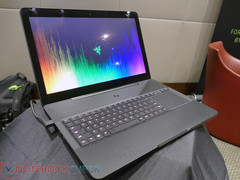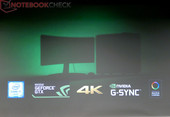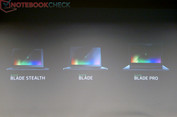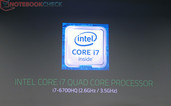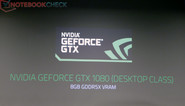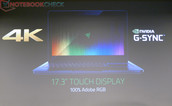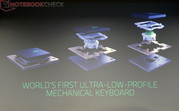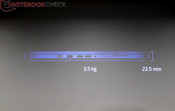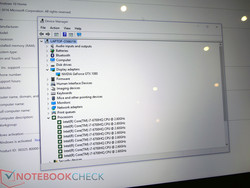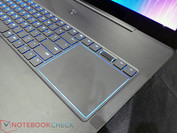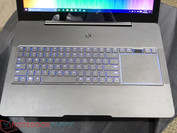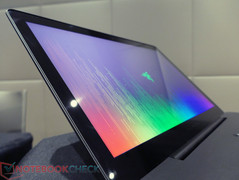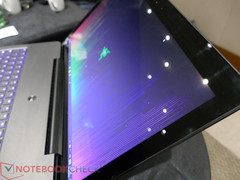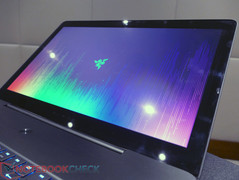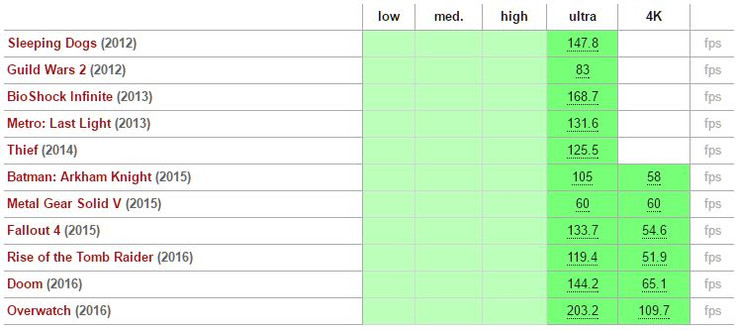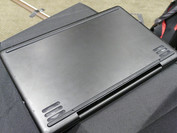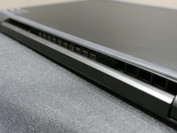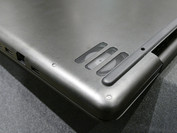Razer tried to confuse the gaming community a bit with a teaser picture of a covered desktop system ahead of today's launch. According to Razer, the new Razer Blade Pro replaces a full-fledged desktop gaming PC. The new Razer Blade Pro 17 is the new flagship model of the line-up and sits right next to the new Blade Stealth and the new Blade 14 at the upper end of the price and performance range.
The idea of creating a desktop in a notebook chassis is not necessarily new, but the realization was always connected with a number of compromises so far. You either had to reduce the performance, or the dimensions of the notebook were so big that you could not really call it a mobile system. Razer now wants to make this "epic split" with the new Blade Pro laptop. We start with a quick look at the components:
Specifications: Intel quad-core CPU and GeForce GTX 1080 GPU
Thanks to the core components GeForce GTX 1080 and Intel i7-6700HQ in combination with up to 2 TB SSD storage and 32 GB RAM, the Razer Blade Pro is definitely a high-end gaming system. Razer also uses high-quality parts for the other components: IGZO display with 4K resolution, G-Sync support and full AdobeRGB color gamut, LAN and Wi-Fi from Killer, Thunderbolt port and HDMI 2.0 as well as the special highlight: a newly designed ultra-thin keyboard with mechanical switches.
- NVIDIA GeForce GTX 1080 (8GB GDDR5X VRAM)
- Intel Core i7-6700HQ Quad-Core processor (2.6 GHz / 3.5 GHz)
- 17.3" IGZO UHD G-Sync, 16:9 aspect ratio, 3840 x 2160, LED backlight, capacitive multi-touch display
- Windows 10 64-bit
- 512 GB SSD RAID 0 (2x 256 GB PCIe M.2) / 1 TB SSD RAID 0 (2x 512 GB PCIe M.2) / 2 TB SSD RAID 0 (2x 1 TB PCIe M.2) options
- 32 GB Dual-Channel RAM (DDR4, 2133 MHz)
- Anti-ghosting keyboard with mechanical ultra-low-profile switches and individually lit keys
- Killer DoubleShot Pro:
Killer Wireless-AC 1535 (IEEE 802.11a/b/g/n/ac + Bluetooth 4.1)
Killer E2400 (Gigabit Ethernet 10/100/1000) - Thunderbolt 3 (USB-C), USB 3.0 port x3 (SuperSpeed), HDMI 2.0 video and audio output, SDXC-card reader, 3.5 mm headphones/microphone combo port, integrated webcam (2.0 MP), array microphone, slot for a Kensington lock
- integrated stereo speakers, Dolby Digital Plus Home Theater-Edition, 7.1 Codec support (via HDMI)
- Razer Synapse-capable wth programmable keyboard, trackpad, illumination and fan control
- Trusted Platform Module (TPM 2.0) security chip
- 99-Wh Lithium-Ion-Polymer battery, 250W-PSU
- Dimensions: 22.5 mm (height) x 424 mm (length) x 281 mm (width)
- Weight: 3.54 kg
Case: Aluminium Unibody with a height of just 22 mm
Customers do not get any surprises for the chassis except for the extremely thin construction when you consider the hardware. The aluminum unibody chassis comes in the familiar matte-black Razer design and it waives any visual gimmicks you often find in the gaming segment. Another typical aspect is the illuminated Razer logo as well as the two light edges at the lid. The build quality is – at least based on our impressions with the pre-production unit – excellent. There is no warping or creaking under pressure. Only the visible fingerprints are an apparent drawback of the matte surfaces.
With a thickness of just 22.5 millimeters and a weight of just 3.6 kilograms, the Razer Blade Pro actually beats many systems with a similar level of performance. The only other similarly powerful competitor right now would be the upcoming Aorus X7 DT v6, which also uses a GTX 1080 GPU in a 23 mm thin and 3.2 kg heavy chassis.
Input Devices: Mechanical keyboard and decentralized touchpad
Razer is particularly proud of its mechanical keyboard with "ultra-low-profile" switches, which was developed in-house. It looks almost like a conventional chiclet keyboard, but you will quickly feel the huge difference during typing. Those keys were designed for a trigger force of 65 grams, which is also accommodated by a clearly perceptible as well as audible click. We also get the Razer Chroma illumination we already know from the smaller siblings. It allows an individual illumination of all keys as well as numerous light effects.
Unusual, but familiar from the predecessor, is the touchpad. It is once again located right next to the keyboard and is supposed to have ergonomic advantages compared to a classic position at the front edge of the chassis. The glass touchpad is a click pad and also gets a customizable surrounding illumination as well as an integrated and configurable scroll wheel at the top. This solution basically worked great during the hands-on, but you should expect a learning period in which you will often try to find the touchpad at the usual position...
Display: 17.3" IGZO UHD G-Sync
The target group includes gaming enthusiasts all the way up to creative users with picture and design applications, so there are obviously high requirements for the display. Razer therefore decides to use an IGZO panel, which is supposed to convince with fast response times as well as very wide color gamut (100 % AdobeRGB). The 4K resolution (3840 x 2160 pixels) is also a good choice for the concept. The majority of modern games should even run smoothly in the native resolution thanks to the GeForce GTX 1080 GPU. Interesting for gamers: Nvidia's G-Sync is supported and could ensure smoother gameplay, particularly in the native resolution.
Performance: "Unthrottled desktop power"
The selection of the processor and the graphics card suggests – at least if the two components can actually utilize their full potential – an excellent level of performance. The graphics performance of the new Razer Blade Pro in particular should be much better compared to the predecessors and siblings since Nvidia's new Pascal GPUs provide a massive performance advantage.
Based on the data of the new GPUs we have collected so far, the GTX 1080 can beat a GTX 1060 (new Razer Blade 14) by more than 80 %, and the GTX 970M in the predecessor of the Blade 14 even by more than 188 %.
| 3DMark 11 - 1280x720 Performance GPU | |
| NVIDIA GeForce GTX 1080 Mobile | |
| NVIDIA GeForce GTX 1060 Mobile | |
| NVIDIA GeForce GTX 970M | |
| 3DMark - 1920x1080 Fire Strike Graphics | |
| NVIDIA GeForce GTX 1080 Mobile | |
| NVIDIA GeForce GTX 1060 Mobile | |
| NVIDIA GeForce GTX 970M | |
In terms of gaming performance, we want to refer on benchmark results for the Nvidia GTX 1080, like in the Eurocom Sky X7E2, for example. Assuming the new Razer Blade Pro will perform on the same level, modern games like Doom or Rise of the Tomb Raider even run smoothly in the native resolution (4K) and the highest settings.
Emissions: "Vapor Chamber" solution is supposed to handle the components
One particular challenge is the heat dissipation from the components, which is not really made easier by the compact chassis. Razer wants to keep the temperatures in check via "Vapor Chamber" solution in combination with four chassis fans and avoid unpleasant hot spots at the chassis at the same time. There are no additional cooling slots at the bottom, but the air is directed from the side openings across the components to the heat exchanger and finally the central fan exhausts at the display hinge. We are very eager to find our how the Razer Blade Pro will perform in our review, because the pre-production unit already had conspicuously warm surfaces while idling.
Price and Availability
The new Razer Blade Pro will be available for a high price of $3699 (4.199 Euros) and is expected to ship in November. It will get localized keyboard options for german, french, UK and US.
Source(s)
own




